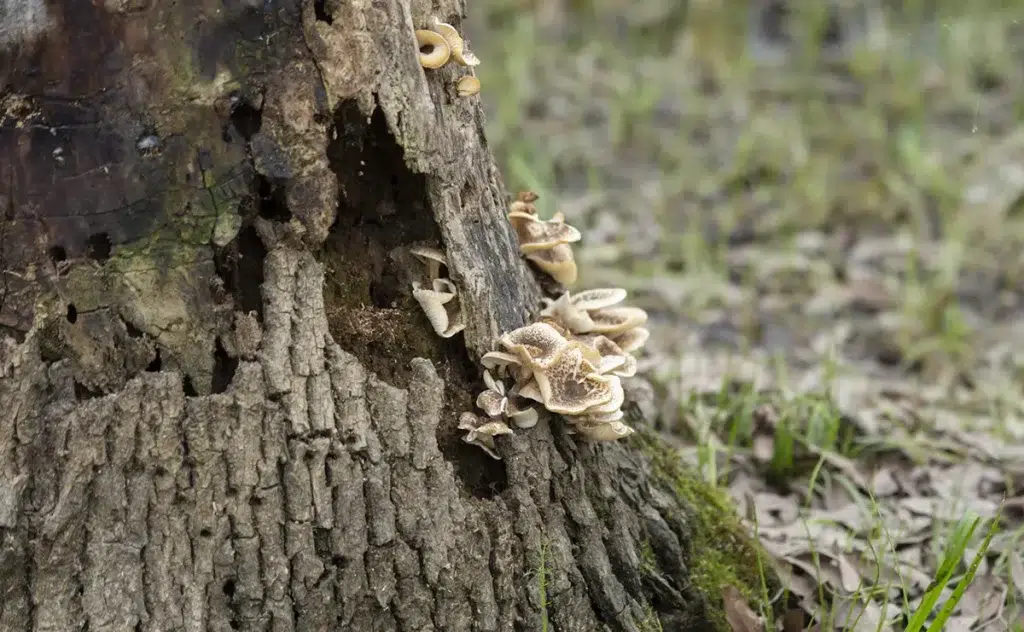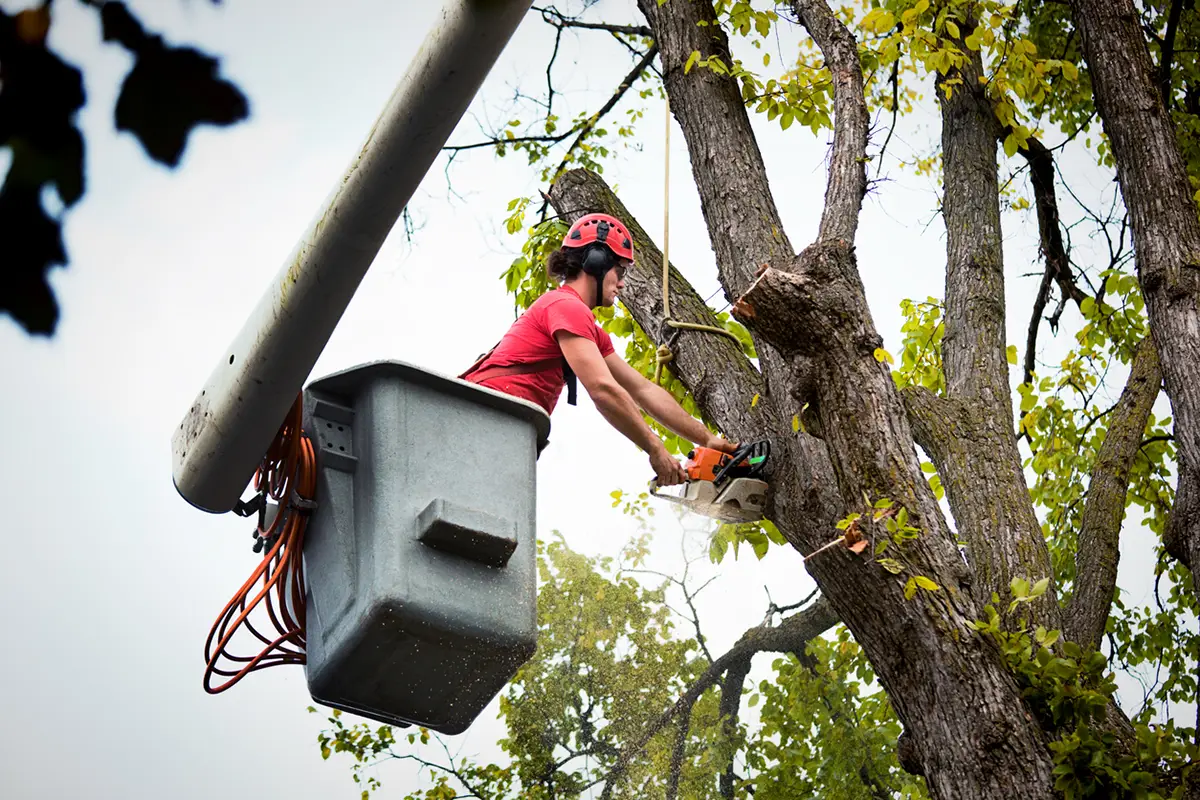Most trees are strong, long-lived assets that add beauty, value, and ecological benefits to your property. But under the surface—or high in the canopy—there can be hidden structural problems that turn a beloved tree into a serious hazard.
As ISA Certified Arborists serving the Greater Pittsburgh area, we at Horhut Tree Experts routinely evaluate trees that appear “fine” to the untrained eye but are actually at high risk of failure. That’s why recognizing the signs of a dangerous tree is critical for protecting people, property, and surrounding plant health.
In this guide, we’ll walk you through six signs that your tree may be dangerous and requires immediate attention, along with what causes these risks and how our expert team can help.
1. Cracks, Splits, or Weak Branch Attachments
One of the clearest signs of a dangerous tree is visible cracking—whether along the trunk, in the major limbs, or at the points where branches connect.
What to Look For:
- Long vertical cracks running down the trunk
- Split crotches between two co-dominant stems
- Cracks near previous storm wounds or old pruning sites
Why It Matters:
These defects often indicate structural instability. In a storm, or even under their own weight, cracked or poorly attached limbs can fail without warning—especially in species like Bradford pear, silver maple, and Siberian elm.
What to Do:
Schedule a professional evaluation. Some cracks can be stabilized through cabling and bracing, but others require removal or pruning to eliminate the hazard.
2. Leaning—Especially if It's Sudden or Severe
All trees lean slightly as they grow toward sunlight. But a new, increasing, or sudden lean is a major red flag.
What to Look For:
- A lean that developed after heavy rain, wind, or snow
- Soil heaving or cracking around the base
- Exposed roots on one side of the trunk
- A lean greater than 15 degrees from vertical
What to Look For:
A sudden lean often signals root plate failure—when the anchoring roots can no longer support the tree. This can be caused by saturated soil, root rot, excavation damage, or even improper planting years earlier.
What to Look For:
This situation is considered high-risk and may require emergency tree removal, especially if the tree threatens a structure or frequently used area. An arborist should inspect immediately.
3. Dead or Hanging Limbs (a.k.a. “Widowmakers”)
Dead branches, particularly large ones high in the canopy, are unpredictable and extremely dangerous.
What to Look For:
- Large branches without leaves during growing season
- Bark falling off branches or limbs
- Branches hanging or broken but not detached
- Previous storm damage that was never pruned
Why It Matters:
These limbs are often called “widowmakers” because they can fall without warning—even on calm days. They pose serious liability risks for homeowners and are a leading cause of tree-related injuries.
What to Do:
Dead limbs should be professionally removed as soon as possible using ANSI Z133-certified safety practices. An arborist can also determine whether the cause is isolated or if the whole tree is in decline.
4. Fungal Growth at the Base or on the Trunk
Mushrooms growing on or near a tree may look harmless, but they often signal internal decay and advanced root rot.
What to Look For:
- Mushrooms, conks, or bracket fungi growing at the base
- Discolored or weeping bark in the lower trunk
- Soft, spongy wood when tapped
- A musty or decaying smell near the root flare
Why It Matters:
Fungal organisms feed on decaying wood inside the tree. By the time these signs appear externally, the structural integrity may already be compromised—especially in mature or urban trees with compacted soil and limited root zones.
What to Do:
Schedule a Level 2 tree risk assessment with an ISA Certified Arborist. Using a mallet, soil probes, and resistance tools, we can assess whether the tree can be stabilized—or must be removed for safety.

5. Root Damage or Restricted Root Zones
The health and stability of a tree begins underground. Damage to the roots—whether from disease, construction, or poor soil health—is a silent but serious threat.
What to Look For:
- Construction or trenching near the tree within the last 5 years
- Cracked sidewalks, curbs, or driveways near the trunk
- Soil compaction or standing water around the base
- Little to no new growth in spring
Why It Matters:
We offer Critical Root Zone Enhancement, including vertical mulching, radial trenching, and soil aeration to restore damaged root systems. If decay is advanced, we may recommend removal.
What to Do:
The health and stability of a tree begins underground. Damage to the roots—whether from disease, construction, or poor soil health—is a silent but serious threat.
6. Tree Suddenly Declines or Stops Leafing Out
A tree that suddenly fails to leaf out in spring, or drops its leaves early in summer, is in serious trouble.
What to Look For:
- Sparse or no foliage during peak growing season
- Yellowing, curling, or scorched-looking leaves
- Dieback starting at the branch tips and moving inward
- Bark sloughing off in large sheets
Why It Matters:
Sudden canopy decline often points to systemic issues—like vascular disease, root failure, or pest infestations (such as emerald ash borer). If left unaddressed, the entire tree may die within a season or two and become unstable.
What to Do:
Early intervention is key. In some cases, systemic treatments, deep root feeding, or pruning can stop the decline. But if structural safety is compromised, we may recommend safe removal.
Why You Should Never Wait to Address a Suspect Tree
Trees in decline rarely improve on their own. Ignoring the warning signs can lead to:
- Personal injury or fatal accidents
- Property damage to homes, vehicles, or power lines
- Insurance claims and legal liability
- Expensive emergency removal services after failure
Proactive care saves money, protects lives, and allows for more preservation options when caught early.
How Horhut Tree Experts Evaluates Dangerous Trees
When you call Horhut Tree Experts for a tree risk evaluation, we don’t guess—we assess. Our ISA Certified Arborists follow a multi-step process that includes:
- Full 360-degree visual inspection
- Canopy, trunk, and root zone evaluation
- History of prior storm damage or pruning
- Species-specific decay profiles
- Level 1, 2, or 3 tree risk assessments
- Soil and root diagnostics if needed
- Transparent, science-backed recommendations
We use ANSI A300 standards to guide every action and maintain full compliance with ANSI Z133 safety protocols on every job.
Our job isn’t to sell services—it’s to protect people and property with expert guidance and precision care.
Common High-Risk Trees in the Pittsburgh Area
Certain tree species and conditions are more prone to structural failure in the Greater Pittsburgh region. These include:
- Bradford Pear: Weak branching structure prone to storm splitting
- Silver Maple: Fast-growing with brittle wood and shallow roots
- Ash Trees: High risk due to emerald ash borer infestation
- Red Maple and Norway Maple: Common urban trees with compacted root zones
- Older Hemlocks: Susceptible to root rot and woolly adelgid
Whether the issue is species-specific or site-related, our team understands the regional risks and how to address them safely.
When in Doubt, Let a Certified Arborist Decide
You don’t need to climb a ladder or tap a trunk to figure out if a tree is dangerous. In fact, you shouldn’t. Tree inspection requires experience, training, and the right diagnostic tools.
If you’ve noticed one or more of the signs listed above, it’s time for a professional evaluation—before the next storm makes the decision for you.
Schedule a Tree Risk Assessment with Horhut Tree Experts
We’ve helped thousands of homeowners across the Pittsburgh region understand and manage tree hazards the right way. Whether you’re concerned about one tree or a full property, we bring decades of experience, full insurance, and expert care to every job.
Serving Mt. Lebanon, Upper St. Clair, Fox Chapel, Sewickley, and the Greater Pittsburgh area.
Call us today to schedule your consultation with an ISA Certified Arborist.

